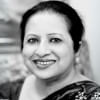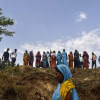Overcoming sexist textbooks to bridge the gender gap in education

For development scholars embracing a feminist agenda, March 7 (International Women's Day) prompts a critical examination of the scholarship we produce. Given the theme of inspiring inclusion, it's imperative to ask: does academic research sufficiently inspire inclusion?
As a development economist, my answer to this question depends on two factors: gender parity among economists themselves (a matter of representation) and in the content they generate (what is researched and taught). Economics has long grappled with a gender problem, evident in the underrepresentation of women among "dismal scientists" and Nobel laureates in economic science. Yet, beyond academia's confines, economics textbooks also fall short in adequately representing women. These disparities sparked my interest in the transformative potential of education and research for societal change.
The most exciting part of being a field economist is the opportunity to learn directly from the lived experiences of respondents across diverse locales. From the Kasur district of Pakistan to climate-affected coastal regions in Bangladesh, and from Jakarta's outskirts to the semi-urban settlements of East Amman in Jordan, I've engaged with women from varied socioeconomic backgrounds. My decade-long stint in Malaysia further enriched my research, allowing for interactions with women ranging from entrepreneurs in Kelantan's Siti Khadijah market to Kelabit farmers in Bario highland, and from Ibans in Lubok Antu of Sarawak, to ageing widows in Sabah's Papar district. Their narratives of empowerment and agency, intertwined with challenges such as poverty, dowry, child marriage, and domestic violence, paint a nuanced picture. A common thread running through the numerous conversations I have had is patriarchal traditions and norms dictating women's life choices, from career and marriage decisions to mundane activities like visiting a doctor or going to the cinema. Communities that prioritise diverse voices and perspectives offer women broader choices.
Consider the case for investing in female education, often hailed as a panacea for women's empowerment. Despite strides in equalising school participation across genders during the Millennium Development Goals (MDGs) era, a significant gender gap persists in labour market participation and leadership roles, even in countries with high gender parity in education. Beyond employment, women grapple with additional barriers such as early marriage and domestic violence. Consequently, rights groups advocate for comprehensive approaches encompassing social protection provisions and legal reforms to ensure gender equality beyond educational access, a sentiment echoed in the United Nations' Sustainable Development Goals (SDGs) framework's recognition of this challenge through Goal 4 (ensure inclusive and equitable quality education and promote lifelong learning opportunities for all) and Goal 5 (achieve gender equality and empower all women and girls).
However, my research across Malaysia, Indonesia, Pakistan, Bangladesh, Afghanistan, and Jordan underscores that post-schooling gender discrimination is itself symptomatic of broader issues entrenched within education systems. Who teaches, and what is taught, in schools about gender roles and responsibilities is a less researched topic. The gender gap in learning materials, exemplified by sexist textbooks, remains a pervasive yet overlooked barrier to realising the full potential of formally educated girls.
As specific examples, my research found the overall proportion of female to male characters to be grossly imbalanced in English secondary textbooks in Pakistan (24 percent) and Bangladesh (37 percent), compared to Malaysia and Indonesia (44 percent). The female share in Pakistan in pictorial indicators was as low as three percent. The use of gender-biased books remains an almost invisible obstacle to realising the full potential of formally schooled girls in countries like Pakistan and Afghanistan.
In fact, textbooks rife with gender stereotypes perpetuate anti-women patriarchal traditions, undermining the transformative power of education by limiting girls' choices in the labour market and for marriage. Conversely, gender-inclusive textbooks hold the potential to bridge the gender gap by empowering female adolescents to make progressive choices and enabling teachers to challenge gender stereotypes effectively.
As we mark this year's International Women's Day amidst the SDGs' second half, my recent collaboration with Dr Amber Webb of the UN's SDG Academy underscores the imperative of prioritising gender equality in educational content production. Let us advocate for the universal adoption of gender-inclusive textbooks in the final years of the SDGs in order to strengthen the nexus between SDGs 4 and 5, paving the way for a more inclusive and equitable future.
M Niaz Asadullah is professor of economics at the School of Business in Monash University Malaysia; co-founder of Integgra, a web-based portal dedicated to research on gender, education and development issues; and is on the advisory board of Feminist Economics.
Views expressed in this article are the author's own.
Follow The Daily Star Opinion on Facebook for the latest opinions, commentaries and analyses by experts and professionals. To contribute your article or letter to The Daily Star Opinion, see our guidelines for submission.

 For all latest news, follow The Daily Star's Google News channel.
For all latest news, follow The Daily Star's Google News channel. 










Comments